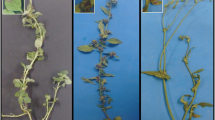Abstract
Typical symptoms of corky root were observed on iceberg lettuce (Lactuca sativa L.) in the Netherlands and England, on prickly lettuce (Lactuca serriola L.) in Spain, and on sowthistle (Sonchus oleraceus L.) in Greece. Slow-growing bacteria with similar colonies as strains ofRhizomonas suberifaciens or otherRhizomonas species were isolated from soil surrounding plants with corky root symptoms using lettuce seedlings as bait. Crude lysate from all strains was tested for DNA homology with DNA fromR. suberifaciens strain CA1 (R. sub. CA1) andRhizomonas sp. strain WI4 (R. sp. WI4). Strains that had homology values higher than that ofR. sp. WI4 orR. sub. CA1 were tested for pathogenicity on 1-wk-old lettuce seedlings, cv. Salinas, Two strains from the Netherlands induced typical symptoms of corky root on lettuce. These strains tested negative with monoclonal antibody MAb-Rs1 specific forRhizomonas suberifaciens in an enzyme-linked immunosorbent assay (ELISA). They had low DNA homology withR. sub. CA1 (4–9%) and low to moderate DNA homology withR. sp. WI4 (4–17%). Some nonpathogenic strains had moderate to high levels of DNA homology withR. sub. CA1 orR. sp. WI4 (19–84%). All strains had fatty acid profiles similar to those ofRhizomonas species. This is the first report ofRhizomonas sp. causing corky root of lettuce in Europe.
Similar content being viewed by others
References
Amin, K.S. & Sequeira, L., 1966a. Role of certain factors in the etiology of corky root rot of lettuce. Phytopathology 56:1047–1053.
Amin, K.S. & Sequeira, L., 1966b. Phytotoxic substances from decomposing lettuce residues in relation to the etiology of corky root rot of lettuce. Phytopathology 56:1054–1061.
Brown, P.R. & Michelmore, R.W., 1988. The genetics of corky root resistance in lettuce. Phytopathology 78:1145–1150.
Busch, L.V. & Barron, G.L., 1963. Root rot of head lettuce in Ontario. Canadian Journal of Plant Science 43:166–173.
Clark, M.F. & Adams, A.N., 1977. Characteristics of the microplate method of enzyme-linked immunosorbent assay for the detection of plant viruses. Journal of General Virology 34:475–483.
Datnoff, L.E. & Nagata, R.T., 1990. Isolation ofRhizomonas suberifaciens in Florida. Plant Disease 74:394.
Dees, S.B., Moss, C.W., Weaver, R.E. & Hollis, D., 1979. Cellular fatty acid composition ofPseudomonas paucimobilis and groups IIk-2, Ve-1, and Ve-2. Journal of Clinical Microbiology 10:206–209.
D'Ercole, N., 1981. La suberosi radicale della lattuga. Colture Protette 10:35–38.
De Vos, P. & De Ley, J., 1983, Intra- and intergeneric similarities ofPseudomonas andXanthomonas ribosomal ribonucleic acid cistrons. International Journal of Systematic Bacteriology 33:485–509.
Guzman, V.L., 1982. Yield and quality response of crisphead lettuce cultivars to seeding dates and farms in south Florida organic soils. Proceedings of the Florida State Horticulture Society 94:182–185.
Guzman, V.L., 1984. South Bay and Raleigh: Two crisphead lettuce cultivars resistant to corky root rot for organic soils. Circular S-310. Agricultural Experiment Station, Institute of Food and Agricultural Sciences, University of Florida, Gainesville. 8pp.
Hartnett, J.P. & Lorbeer, J.W., 1971. The production of a noninfectious lettuce root rot under controlled environmental and soil conditions. Phytopathology 61:1153–1158.
Hoff, J.K. & Newhall, A.G., 1960, Corky root rot of iceberg lettuce on the mucklands of New York, Plant Disease Reporter 44:333–339.
Jochimsen, K.N. & Van Bruggen, A.H.C., 1990. Classification ofRhizomonas suberifaciens, the causal agent of corky root of lettuce, in superfamily IV. Phytopathology 80:964.
Lucas, R.E. & Guzman, V.L., 1980. The incidence of corky root rot of lettuce due to soil moisture levels, nitrogen sources, and potash rates. A greenhouse study. Belle Glade ARFC Report EV-1980-10. University of Florida, Gainesville, Florida. Pages 43–46.
Matkin, O.A. & Chandler, P.A., 1957. U.C. Type Soil Mixes for Container-grown Plants. California Agricicultural Experiment Station Extension Service. Leaflet 89. University of California, Berkeley.
Moore, C.J., Mawhinney, H. & Blackall, P.J., 1987. Differentiation ofBordetella avium and related species by cellular fatty acid analysis. Journal of Clinical Microbiology 25:1059–1062.
Owen, R.J. & Pitcher, D., 1985. Current methods for estimating DNA base composition and levels of DNA-DNA hybridization. Chemical Methods in Bacterial Systematics. Society for Applied Bacteriology, Technical Series 20:67–93.
Patterson, C.L., Grogan, R.G. & Campbell, R.N., 1986. Economically important diseases of lettuce. Plant Disease 70:982–987.
Sequeira, L., 1970. Resistance to corky root rot in lettuce. Plant Disease Reporter 54:754–758.
Van Bruggen, A.H.C., Brown, P.R. & Jochimsen, K.N., 1989. Corky root of lettuce caused by strains of a gram-negative bacterium from muck soils of Florida, New York, and Wisconsin. Applied and Environmental Microbiology 55:2635–2640.
Van Bruggen, A.H.C., Grogan, R.G., Bogdanoff, C.P. & Waters, C.M. 1988. Corky root of lettuce in California caused by a Gram-negative bacterium. Phytopathology 78:1139–1145.
Van Bruggen, A.H.C., Jochimsen, K.N., Benedict, A.A. & Pollard, L.W., 1991. Monoclonal antibodies for the detection ofRhizomonas suberifaciens, causal agent of corky root of lettuce, with enzyme immuno-assays. Food and Agricultural Immunology 3: (in press).
Van Bruggen, A.H.C., Jochimsen, K.N. & Brown, P.R. 1990.Rhizomonas suberifaciens gen. nov., sp. nov., the causal agent of corky root of lettuce. International Journal of Systematic Bacteriology 40:175–188.
Yabuuchi, E., Yano, I., Oyaizu, H., Hashimoto, Y., Ezaki T. & Yamamoto, H., 1990. Proposals ofSphingomonas paucimobilis gen. nov. and comb. nov.,Sphingomonas parapaucimobilis sp. nov.,Sphingomonas yanoikuyae sp. nov.,Sphingomonas adhesiva sp. nov.,Sphingomonas capsulata comb. nov., and two genospecies of the genusSphingomonas. Microbiology and Immunology 34:99–110.
Author information
Authors and Affiliations
Rights and permissions
About this article
Cite this article
Van Bruggen, A.H.C., Jochimsen, K.N. First report of Rhizomonas sp. causing corky root of lettuce in Europe. Netherlands Journal of Plant Pathology 98, 45–56 (1992). https://doi.org/10.1007/BF01998077
Accepted:
Issue Date:
DOI: https://doi.org/10.1007/BF01998077




